posted by Dr. Amber Jenkins
09:57 PST
Dr. Josh Willis, ocean guru at NASA's Jet Propulsion Laboratory, spoke to TV channel KCET recently about what sea level rise will mean for California and our coasts. Here's the interview.


Amber Jenkins is Editor of NASA's Climate Change website and project manager of the Center for Climate Sciences at NASA's Jet Propulsion Laboratory. She's passionate about climate change, science and science communication.
More ›
Dr. Josh Willis, ocean guru at NASA's Jet Propulsion Laboratory, spoke to TV channel KCET recently about what sea level rise will mean for California and our coasts. Here's the interview.

An interesting recent paper from Dr. Son Nghiem at NASA’s Jet
Propulsion Laboratory and colleagues finds that the bottom of the Arctic Ocean
controls the pattern of sea ice thousands of feet above on the water’s surface.
The seafloor topography exerts its control not
only locally, in the Bering, Chukchi, Beaufort, Barents and Greenland Seas, but
also spanning hundreds to thousands of miles across the Arctic Ocean.
How? The seafloor influences the distribution of cold and warm waters in the Arctic Ocean where sea ice can preferentially grow or melt. Geological features on the ocean bottom also guide how the sea ice moves, along with influence from surface winds.
Interestingly, the study also links the bottom of the Arctic Ocean with cloud patterns up in the sky. The ocean bottom affects sea ice cover, which affects the amount of vapor coming from the surface of the ocean out into the air, which in turn influences cloud cover.
The researchers, who also come from NASA's Goddard Space Flight Center, the Applied Physics Laboratory and the National/Naval Ice Center in the U.S., use sea ice maps taken from space with NASA’s
QuickSCAT satellite, as well as measurements from drifting buoys in the Arctic
Ocean. They compare the sea ice and seafloor topography patterns to identify
the connection between the two.
Bottom line:
Since the seafloor does not change significantly over many
years, sea ice patterns can form repeatedly and persist around certain
underwater geological features. So computer models need to incorporate these
features in order to improve their forecasts of how ice cover will change over
the short- and long-term. This ‘memory’ of the underwater topography
could help refine our predictions of what will happen to ice in the Arctic as
the climate changes.
Source:
“Seafloor Control on Sea Ice,” S. V. Nghiem, P. Clemente-Colon, I.G. Rigor, D.K. Hall & G. Neumann, Deep Sea Research Part II: Topical Studies in Oceanography, Volumes 77-80, pp 52-61 (2012).


Climate change makes headlines, but not so much box office or TV hits. In an effort to inject more realistic climate-related story arcs into the silver screen, NASA climate experts and Hollywood entertainment writers and producers came together last month to chat. A bus of writers and producers (from TV series such as Grimm and Curious George) dropped in on NASA’s Jet Propulsion Laboratory to hear about topics ranging from the impact of global warming on the Amazon rainforest to potentially new sources of sustainable energy involving microbes living inside termites. And in an “Entertaining Climate Change” event held in Los Angeles, producers, writers, filmmakers and artists came to listen to Dr. Jim Hansen, one of NASA’s best-known climatologists, talk about how real people are being affected by climate change now. They also learned how NASA’s suite of satellites monitors climate change around the planet and how we visualize that information.
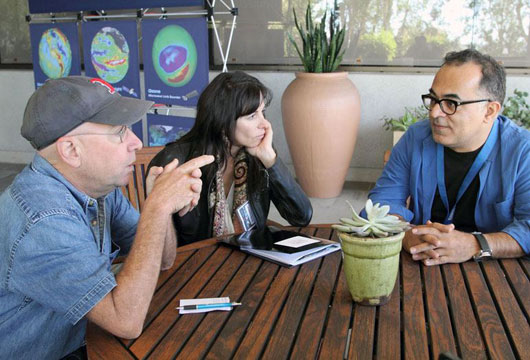 Writers John Vorhaus (left) and Cindy Lichtman listen to Dr. Sassan Saatchi of NASA JPL discuss the effects of climate change on forest ecosystems. Photo by Howard Pasamanick.
Writers John Vorhaus (left) and Cindy Lichtman listen to Dr. Sassan Saatchi of NASA JPL discuss the effects of climate change on forest ecosystems. Photo by Howard Pasamanick.
 Writer Spiro Skentzos listens to a presentation.
Writer Spiro Skentzos listens to a presentation.
The tour was organized by Hollywood, Health and Society (HH&S), a program of the University of Southern California’s Annenberg School for Communication and Journalism based in Los Angeles. The tour was part of a new collaboration between climate.nasa.gov and the Annenberg School. HH&S hooks up entertainment industry professionals with accurate, timely information that can be used in health- and climate-related plotlines — information that is unusual, compelling and dramatic, but based on real stories about real people and places. Global instability, infectious diseases and drought are all examples of real-life storylines that are linked to climate change and that could make for thought-provoking entertainment.
 The Hollywood, Health and Society group poses with a model of the Mars Rover Curiosity.
The Hollywood, Health and Society group poses with a model of the Mars Rover Curiosity.
At present, TV storylines about climate change are “close to zero”, explained HH&S Director Sandra de Castro Buffington. An HH&S TV monitoring project earlier this year looked at more than 3,000 storylines used in the top 28 scripted TV shows, and found that only 24 of them — less than one percent — dealt with climate change, and most of them only peripherally.
This effort is trying to change that. While you may not see “CSI Climate”, “Attack of the Frankenstorms” or “Extreme Weather Makeover” anytime soon, hopefully TV programs and movies will soon begin to reflect the reality of climate change.
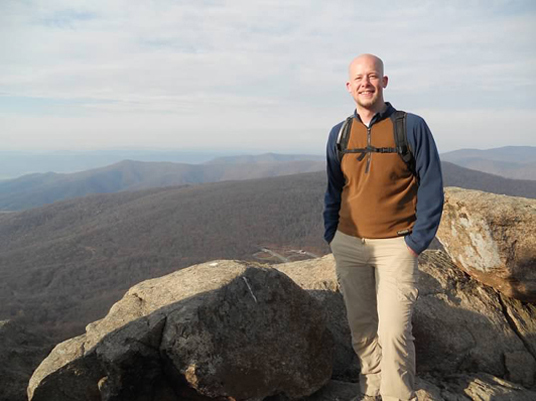
Jason Tackett is an analyst/programmer for the NASA satellite mission CALIPSO at NASA Langley Research Center. He is a proud member of a team of scientists who develop algorithms for this unique instrument that probes Earth’s atmosphere using pulses of laser light.
I was a musician working at a Pizza Hut before beginning college which, in my case, was synonymous with poor. Looking for a brighter future (i.e., more money), I enrolled at Kansas State University as a computer systems major. The alluring thing about this major for me was that it required creative problem solving and had the promise of big bucks. During my time there I learned about programming and computer hardware.
However, the most important thing to happen to me was a course I took in calculus. Before I started college I assumed that math wasn’t for me. As it turned out, I found mathematics very intuitive. I enjoyed the creativity and elegance that came with problem solving, much like the creativity I enjoyed playing music. My original childhood passion was astronomy, and if I enjoyed mathematics then I reasoned that I could do well studying astronomy or physics.
With this in mind, I wrapped up my associates degree in computer systems and changed majors to physics in which I earned my bachelor’s degree. I became interested in the physics of light and lasers, so I did research as an undergraduate in a high-intensity ultrafast laser facility at the James R. Macdonald Laboratory at Kansas State University. I wrote computer code for graduate researchers that helped with their experiments and also spent six months assembling a laser system.
In graduate school, atmospheric science was an attractive path because I could apply the physics I learned to important problems such as climate and climate change. When I sent out my application to graduate schools, my soon-to-be advisor at the University of Illinois at Urbana-Champaign saw that I had experience with lasers and thought that I could work with data from the new (at the time) CALIPSO satellite which uses lasers to study the atmosphere. I hadn’t thought about working with satellites before I met him, but because it sounded interesting and involved lasers and the physics of the atmosphere, I jumped on board. I spent the next two years studying CALIPSO measurements to learn how aerosol properties change near clouds – a topic of significant uncertainty in climate science.
Eventually, I was ready to look for a job and, as it happened, an opportunity opened up for an analyst with the CALIPSO science team at NASA Langley Research Center. Since I had been working with CALIPSO data for two years and my interest in optics and aerosols fit in well with the team, I was offered the job, which I eagerly accepted – and every day since I have been glad that I did.
Working for the CALIPSO satellite mission is very exciting. I get to find creative solutions to complicated problems and work with scientists to understand what data from CALIPSO is telling us about Earth’s atmosphere. In April 2010, I worked with colleagues to examine the distribution and optical properties of volcanic ash that had erupted from the Icelandic volcano Eyjafjallajökull and disrupted air traffic in Europe. NASA Headquarters asked several Earth observing satellite groups, including ours, to help identify plume location and provide guidance to air traffic controllers.
Since I have been with the CALIPSO team, my colleagues and I have also developed products for near-real time air quality monitoring and for climate modelers. I feel immense satisfaction that I work with a team that provides the high quality data that climate researchers need to solve the important issue of climate change.
It hasn’t been a straight path to get where I am today, but I am very happy with where I’ve landed.
Learn more about Earth Science Week and NASA’s Earth Explorers: http://climate.nasa.gov/esw2012/

Guest blogger Bill Patzert, a climatologist at JPL, tells about the personal journey that led him toward a career in Earth science.
I mostly grew up in Gary, Indiana on the shores of Lake Michigan (a smallish ocean) surrounded by great Pleistocene sand dunes. Meteorologically, we had blizzards, sweltering summers and even tornadoes.
My dad was a sea captain and taught me celestial navigation, shooting the stars and the sun with a sextant. At night he would point out the North Star and the many constellations and tell me about the mythology of each. This was heady stuff and fascinating for a budding geek. For my generation, Sputnik was huge. We became the first space-nut generation. Sputnik and the Jet Propulsion Laboratory's (JPL**) Explorer 1 gave many of my classmates and me the 'space bug.'
The opportunity for adventure presented itself in an unusual manner. I'd blown out my knee playing basketball and dropped out of college my freshman year and ran away to sea. I hitchhiked to New York and worked for a seaman's union in Brooklyn. Friends of my dad put me to work on a tramp freighter. I went around the world. I spent a week in Bali surfing and diving, then back across the Pacific through two great big typhoons.
Eventually, I went back to school and double-majored in physics and math at Purdue. I also double-minored in American literature and geology. One winter, I saw this book on surfing in Hawaii. Soon I was headed to Hawaii for graduate school. I got up at five in the morning, went surfing, then off to class and studied in the evening. A few years later, I had earned a doctorate in oceanography and meteorology.

In the 1970s, the vast oceans and the global atmosphere were poorly sampled. Those years were filled with travel for research to Tahiti, islands in the Pacific, Australia, Indonesia, South America, Southeast Asia and many other places I had dreamed of as a boy. I saw much of the world, had great adventures and gained a deep appreciation about the great forces of nature.
In the early 1980s, oceanography was about to enter the space age. The National Oceanic and Atmospheric Administration (NOAA) was flying satellites that were revolutionizing weather forecasting and NASA was planning for a suite of ocean-observing spacecraft.
Remembering the excitement of Sputnik and witnessing the birth of America's new space program, I hung up my sea boots and cast my future and fortune with NASA and JPL.
That gamble has been wildly successful. The TOPEX/Poseidon, Jason-1 and Jason-2 ocean satellites have been flying for 20 years. These height-measuring observatories have revolutionized oceanography and climate research.
Although I miss hearing the surf and donning the wetsuit every few days, I really enjoy being at JPL. I love to speak with students, civic and environmental groups, and, even, politicians. After speaking all over Southern California for almost three decades, I'm still surprised and delighted with the people I meet.
Today, there are great issues that must be addressed - climate change, our economy, human rights, poverty and many others. The problems the global community is dealing with now - the deficit, war and poverty - will be dwarfed by climate change, sea-level rise, a warming world, and change in agricultural and rainfall patterns.
What happens when you have nearly sixty million people in California and no water? In the old days, the Anasazi just dispersed throughout the Southwest. Now we're 95% urban. So we're definitely not going to put L.A. in a backpack and move to British Columbia. Climate change is the real deal. I want to contribute to the dialogue and, hopefully, a better future.
Yep, still dreaming here at JPL.
Post by Bill Patzert, Climatologist, Jet Propulsion Laboratory (http://science.jpl.nasa.gov/people/Patzert/)
Learn more about Earth Science Week and NASA’s Earth Explorers: http://climate.nasa.gov/esw2012/

If somebody had told me that 2012 would bring with it a deployment to Greenland, Chile, and possibly Antarctica, I never would have believed them. But here I am reflecting back on my three weeks in Kangerlussuaq, Greenland, as I pack for Punta Arenas, Chile. These experiences have been made possible by my new assignment as the project manager of a NASA airborne geophysical project called Operation IceBridge (OIB).
I started full-time work with OIB this past March. What I truly enjoy about this project is the remarkably talented and extensive team I work with. As the project manager, I must coordinate and help lead a vast team of experts spread out across the country. This team includes polar scientists, instrument engineers, educational/outreach teams, logistics teams, data centers, and aircraft offices. I have to utilize good leadership and communications skills to help my integrated team work together smoothly to achieve a common goal and meet all of our science objectives.
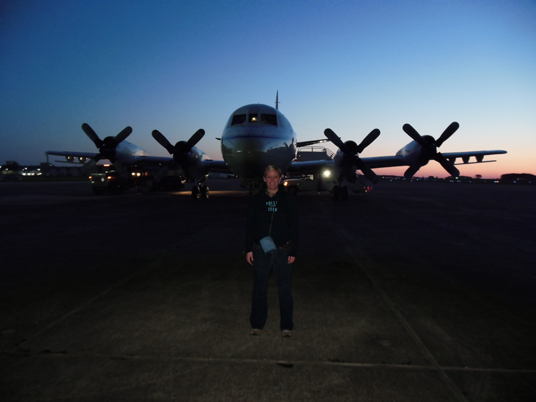 Christy Hansen stands in front of an airplane at Wallops Flight Facility in Virginia. This plane took her to Greenland this past April. Credit: Matt Linkswiler
Christy Hansen stands in front of an airplane at Wallops Flight Facility in Virginia. This plane took her to Greenland this past April. Credit: Matt Linkswiler
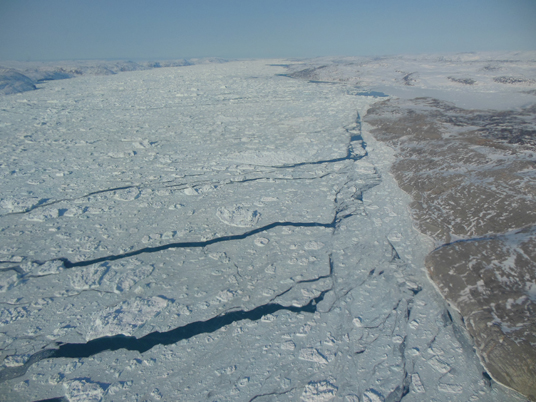 A view of sea ice with open leads of water. Credit: Christy Hansen
A view of sea ice with open leads of water. Credit: Christy Hansen
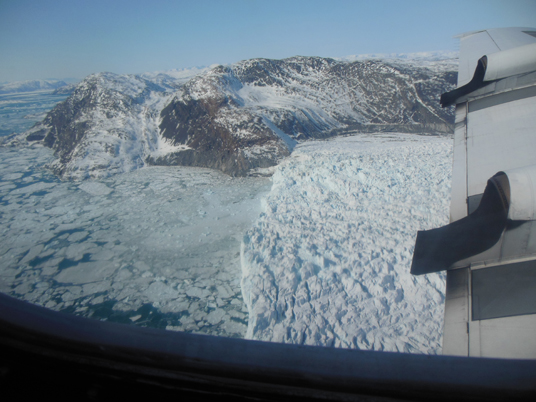 An image of a glacier’s calving front, where it flows and loses ice to the sea. Credit: Christy Hansen
An image of a glacier’s calving front, where it flows and loses ice to the sea. Credit: Christy Hansen
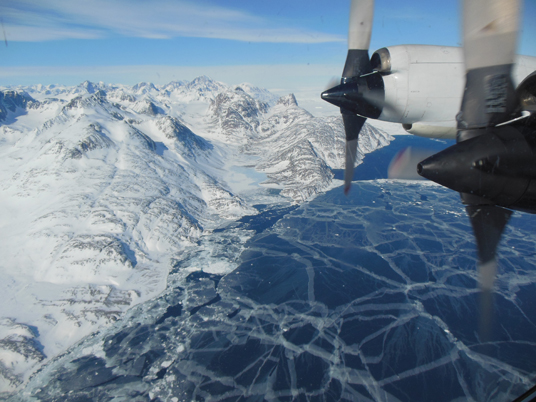 The plane flies over sea ice. The P-3B propeller can be seen out the window of the plane. Credit: Christy Hansen
The plane flies over sea ice. The P-3B propeller can be seen out the window of the plane. Credit: Christy Hansen
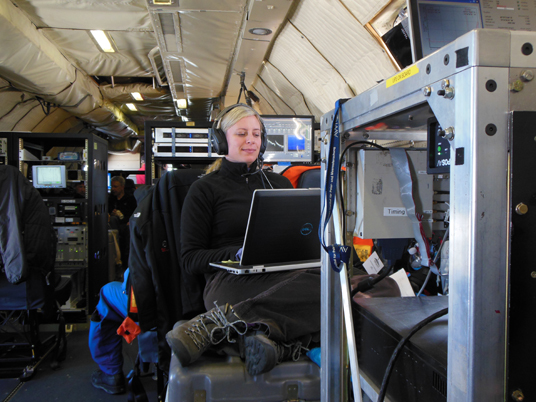 Christy sitting on a toolbox working on the plane during flight surrounded by various instrumentation. Credit: Christy Hansen
Christy sitting on a toolbox working on the plane during flight surrounded by various instrumentation. Credit: Christy Hansen
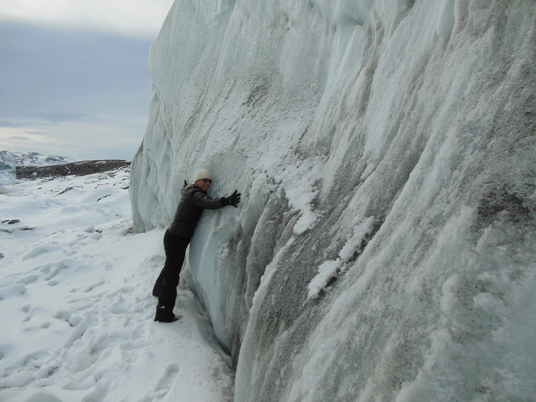 Christy Hansen hugs the Russell glacier, part of the Greenland Ice Sheet. Credit: Christy Hansen
Christy Hansen hugs the Russell glacier, part of the Greenland Ice Sheet. Credit: Christy Hansen
More information: Google+ Hangout with Christy Hansen http://climate.nasa.gov/eswSite/eswEvents/HansenEvent/
Career Spotlight: Christy Hansen http://climate.nasa.gov/eswSite/eswVideos/ChristyHansen/
NASA Earth Science Week Website http://climate.nasa.gov/esw2012/
Operation IceBridge http://www.nasa.gov/mission_pages/icebridge/index.html

Guest blogger Holly Shaftel was an intern for the Earth Science Communications Team in the summer of 2010 and now works as an editorial assistant for the Global Climate Change website.
Over the summer I went on three vacations: a Mediterranean cruise (it was hot), a Vegas weekend (it was pretty darn hot) and a Lake Mohave getaway (you couldn’t get me out of the water).
While I enjoyed these trips, the heat just seemed unreal. My brain began to function at about a quarter capacity, and most of the time I was tired enough to sleep 15 hours a day (which happened).
I’m a healthy 23-year-old female, but it seemed being outdoors was enervating me. I began craving a Russian November.
But high summertime temperatures are normal, so why am I fussing? Climate scientists, like NASA's James Hansen, link this extreme weather to climate change. Using a standard bell curve to compare temperatures from 1981 to present with those from 1951 to 1980, they discovered that 75 percent of Earth’s land had been beset with heat waves (compared to 33 percent from 1951 to 1980). They labeled some unique cases with a new term: “extremely hot.”
Moreover, NOAA describes the summer of 2012 as the third hottest summer on record, and the cause of drought in 63 percent of the contiguous U.S. The organization associates these conditions with the record-setting wildfires that burned up a chunk of the West.
Obviously there’s a still a big problem with our planet, and that’s why I’ve returned to JPL—this time as a graduate student. While many people of my generation seem more focused on jobs and the economy (valid concerns), I still argue that global climate change is not something we should ignore, especially after the recent news on the new Arctic low. That was a landmark moment, one of many signs that our planet is changing significantly.
But despite climate change’s irrevocable features, I think humanity can still make positive changes to deal with what’s coming for our ecosystems and health. That optimism—along with those obnoxious heat waves and the record ice melt—prompts me to continue representing my age group as steps are taken toward long-term adaptation.
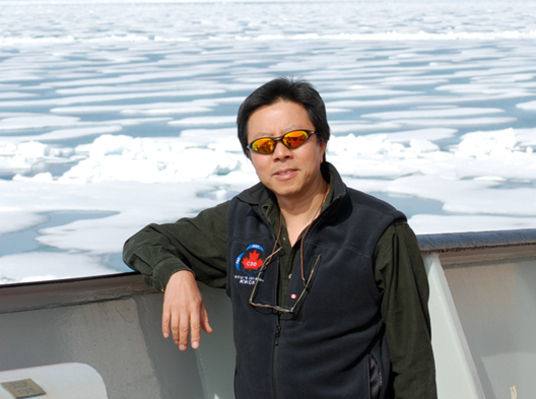
Guest blogger Ron Kwok is a senior research scientist at NASA's Jet Propulsion Laboratory.
Since I study sea ice and have traveled to the Arctic to do research, I've had a lot of people ask me what I think about this year's ice extent. People want to know if I'm surprised by the new record this year.
The extent of the ice, a measurement of the area that the ice covers, has been trending downwards since the beginning of satellite measurements, so every few years we expect to hit a new record low.
I'm not surprised at this new low because we scientists expect it due to warming. But also yes I am surprised because the interval between record lows seems to be getting shorter over the past decade. 2005, 2007, and then this summer were all years with record low sea ice extent.
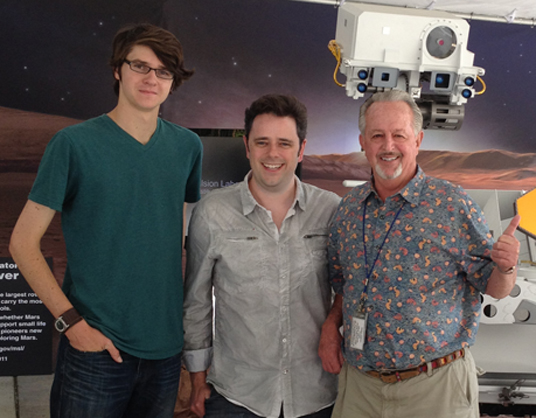
Guest blogger Alec Loorz is the 18-year-old founder of the iMatter Campaign and a climate change activist and public speaker. He just completed a summer internship with the Earth Science Public Engagement Team at NASA's Jet Propulsion Laboratory.
Just a few months ago my understanding of NASA wasn’t much more than “yeah they sent a man to the moon” and “that’s a pretty picture of the Earth.” Now, after four months of interning at NASA’s Jet Propulsion Laboratory in Pasadena, I realize there is so much more. In an agency whose main driving force is an insatiable curiosity about Earth and the universe, I see the work of NASA and JPL as a perfect model of the sense of wonder a lot of us tend to lose track of.
I’m 18 years old, and I’ve always been driven by an intense desire to be constantly learning, constantly discovering new things. And whether it’s about volcanoes, mushrooms, or the mysteries of space, I’ve always been completely and utterly in awe of the magnificence of the universe.
But as I’m growing older I’m noticing this sense of amazement beginning to fade. Overwhelmed by the endless sea of expectations and cynicism imposed by our society, my sense of awe is being walled in and suppressed. In our culture, wonder is considered childish, being in awe of the world is seen as naïve, and inquisitiveness is threatening. Out in the world, we are constantly encouraged to “grow up” and “get over it.” But not at the Jet Propulsion Laboratory.
At JPL, wonder is the most important thing there is. Being in awe of the universe is the reason we are alive, the reason that 5,000 people are gathered together in this Disneyland-sized facility to send robots into space. Inquisitiveness is the expectation. Exploration is in our nature.
This Sunday, JPL will operate the landing of the Mars Science Laboratory on Earth’s red neighbor. It’s one of the most advanced machines ever sent into space, and its goals are to determine whether Mars could have ever supported life, to study the climate and geology of the planet, and even to plan for human missions in the future. There’s a reason the rover is named Curiosity.
And I’ve been working in the Earth Science division, where JPL operates a handful of satellites and instruments that measure things like CO2 and Earth’s gravitational field. In these missions, our sense of wonder becomes practical. Because in the data gathered by these satellites, there are some very obvious warning signs that something is not right. It’s become clear that human activities like fossil fuel burning and deforestation have knocked the delicate systems of Earth out of balance. And the research done here at the lab makes it much easier to understand the nature of these imbalances so that we can more intelligently deal with them.
So here’s to curiosity. Here’s to wonder. Here’s to returning to the sense of awe we were all born with, and tearing down the walls of jaded apathy built by an unbalanced society. We have the privilege of living on Earth as human beings in one of the most exciting times in history. So let’s not waste it. Go out and learn something new. Do something today you’ve never done before. There’s a whole universe out there waiting to be explored.
And it is truly awesome.